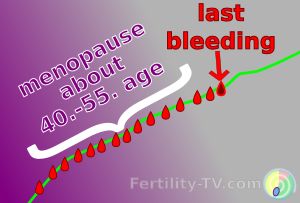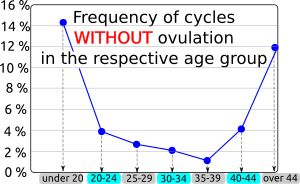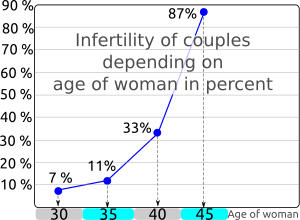 How to get pregnant during the Climacteric Period before menopause? In this article, you get information about how you can boost your fertility.
How to get pregnant during the Climacteric Period before menopause? In this article, you get information about how you can boost your fertility.
What does Climacteric Period actually mean?
The Climacteric Period spans over a period of about 10 to 15 years and starts with most women in their early 40s. The end of the climacteric period is menopause – i.e. the last bleeding in a woman’s life. Most women have their menopause with 50 to 55 years. Menopause can only be recognized in hindsight since you can never really know if it was the last bleeding. Thus, according to the definition, menopause happens when there is no more bleeding for a year. But this does not mean that after two years a bleeding can still not occur – it is only very unlikely.
How do I know I’m in the climacteric period?
This is difficult to answer. I think there are three clues that you can follow!
Low AMH value
The Anti-Müllerian hormone is currently medically seen as – the best marker for the onset of Climacteric period. The anti-Müllerian hormone (AMH) is in direct contact with the egg reserve, i.e. the number of potential eggs that are still fertile to get you pregnant! The egg reserve drops in old age – if the AMH value is below 1 – this is already a strong sign that there is not much time left to have children. However, the AMH value is not a valid criterion, as it can fluctuate over the day and the doctors still have problems due to the current measurement methodology. Overall, however, doctors agree that the AMH is probably the most important hormone for predicting climacteric period. Studies with nearly 3,000 women show that AMH predicted climacteric period relatively correctly in about 80% of cases. The AMH is particularly strong in predicting when the climacteric period comes very early, for example at 30 years of age. However, the evaluation of a comprehensive AMH analysis is currently only possible by a specialist. Likewise, I believe that an AMH analysis is certainly not easy mentally. Let’s say you go to the gynaecologist at the age of 30 and learn that you are in the climacteric period. You have to digest that first for sure. Currently, many tests for the climacteric period are being offered on the internet for a lot of money, much like pregnancy tests. These are based, but not on the AMH, and therefore cannot be reliable and reputable. Please go to the doctor and let it be clarified – a diagnosis with any home based hormonal tests is not recommended. However, I can imagine that at some point proper AMH tests for the home will exist.
Cycle Diagnostic
Those who observe their cycles over a longer period of time can already see signs of the climacteric period. If you have a menstrual calendar, you can see the lengths of your cycles and your bleeding duration and strength over the past few years. You can calculate the length of a cycle by summing up the days from the first day of bleeding to the day before the next bleeding begins. If you have been observing your cycles in recent years with Fertility Awareness or the Symptothermal method, you can see even more clearly and impressively whether you are at the beginning of your climacteric period.
 The first signs of the onset of the climacteric period are: altered bleeding patterns, occasionally very strong bleeding, shorter cycles, ovulation gradually takes place earlier, possibly even monophasic cycles can occur without ovulation. Women often see changes, even in the cervical mucus. During the climacteric period, women experience that their vagina becomes increasingly dry. The mucus phases of S or S+ mucus decrease in comparison to before.
The first signs of the onset of the climacteric period are: altered bleeding patterns, occasionally very strong bleeding, shorter cycles, ovulation gradually takes place earlier, possibly even monophasic cycles can occur without ovulation. Women often see changes, even in the cervical mucus. During the climacteric period, women experience that their vagina becomes increasingly dry. The mucus phases of S or S+ mucus decrease in comparison to before.
Other Climacteric Period Symptoms
There is a very long list of symptoms for the climacteric period, which one can, of course, add to the really striking changes in the AMH value or the cycle. However, a symptom alone is not yet a sign of climacteric period. In the climacteric period, for example, more sleep disorders occur, as well as weight gain as a result of hormonal changes and mood swings and the increase in the risk of Osteoporosis.
How do the cycles change during the climacteric period?
When the first signs that I have explained in the previous section have begun, in the course of the next approximately 10 to 15 years your cycles will slowly but surely become irregular. This really happens very slowly and can be followed gradually by the cycle observation. So, if you are already in the later stages of the climacteric period, you can also observe very irregular cycles alternating with typically very short cycles under 23 days followed by very long cycles over 35 days. The closer the climacteric period gets, the longer the intervals between the bleeding become, i.e the cycle length. For example, cycles without ovulation may occur more often without temperature increase and without cervical mucus. You may feel like you were in puberty again? Always on call, it may be that your days could start right now because you can no longer predict when your menstruation will come. Of course, if you use the Symptothermal Method, you have a clear advantage, because you know exactly when your bleeding starts due to the knowledge that the bleeding occurs about 10 to 16 days after your ovulation.
Can I get pregnant during the Climacteric Period?
Getting pregnant from 40+ with the Symptothermal Method during the climacteric period – How does it work? Everything about the desire to have children during the climacteric period, cycle change etc.
Yes, you can get pregnant during the climacteric period. The climacteric period is a long period of 10 to 15 years in which, of course, much can happen. In addition to the climacteric period, age is probably the most crucial factor in the chances of getting pregnant. In order to really evaluate the natural fertility without drugs and environmental factors – many researchers are looking at historical data – from a time when there was still no contraception like today. A study from the year 1957 came to the following result. At the age of 30, 7% of the couples were barren and had no children. At the age of 35, there were 11%, at the age of 40 33% and from an age of 45, 87% of the couples were barren. Experts assume that due to stress, environmental factors and nutrition etc. These figures are somewhat lower today. All the studies I’ve looked at show a decrease in fertility with age, but with different percentages. However, all studies also show that there is always a slight chance of getting pregnant – even if you are at the age during which the climacteric period typically occurs. From our experience, you can get pregnant as long as you have a natural cycle of bleeding and ovulation. The oldest woman and mother who has become pregnant with our help, of course, thanks to the Symptothermal Method was 43 years old.

infertil in age of woman – study (1957)
In this context, I would like to mention briefly that the Symptothermal Method can significantly increase the pregnancy rate after a long wait, even in women from 35+. This was undoubtedly found in a Study from the year 2017, in which one only studied couples who have been trying to get pregnant for at least a year. To learn the Symptothermal Method as fast as possible, we recommend our eBook WHEN AM I FERTILE? with which even women over 40+ have get pregnant.
Getting pregnant during the climacteric period without a period?
If your climacteric period is a bit more advanced, you may not have your period for a long time. In this case, it is very likely that you will soon have your last bleeding (menopause). If you still want to get pregnant naturally, I recommend that you always have sex whenever possible on days when you notice cervical mucus. During the cervical mucus phase, it is most likely that you will have ovulation on these days – even if you may have not observed bleeding for many months.
Get Pregnant at 50+?
Of course, there are not so many women who have become naturally pregnant with over 50 years of age, but they do exist! Statistically, it is really unlikely and yet they did it – congratulations to Brigitte Nielsen (54 years old), Soraya Lewe-Tacke, the mom of Sarah Connor (50 years old), Gianna Nannini (54 years old) ) Who else? … In any case, it seems to be very individual when natural fertility ends. Wikipedia even has an article in English with many women who have become pregnant over 50+. In this list, however, not only natural pregnancies are listed. The oldest listed woman with a natural pregnancy and natural fertilization is 55 years old. That’s impressive.
Does the cycle observation with the Symptothermal Method also work during the climacteric period?
Definitely, yes. The cycle observation with the Symptothermal Method works in every phase of life – also in puberty, lactation and climacteric period. As long as you are still in the pre-menopause period (last bleeding), there are always fertility signs that you can observe. At the end of the climacteric period – i.e. about one to two years before menopause – you can, even in extremely long cycles, that go for months, always watch cervical mucus phases and changes to the cervix. So you can still determine your fertile period, even if the intervals between your bleeding fluctuates between about 20 and 200 days.
Psychological aspects of getting pregnant during Climacteric period
Many women over the age of 40 trying to get pregnant, report a very high psychological burden. On the one hand, they want to do everything they can to get pregnant and on the other hand, they often worry about whether they are already “too old, too far into the climacteric period or whatever”. These self-doubts, of course, are not conducive to getting pregnant. There are also various sayings and headwinds from outside. It can often lead to negative criticism from the ranks of our own parents and relatives as well as the medical care. Either you are aware of this before and can withstand it, or you go out of your way and just don’t tell the public that you’re just trying to get pregnant.
Increasing fertility during the climacteric period
First of all, it is basically said that the biological clock cannot be turned back. However, you can get the maximum out of the available fertility. The fact is that the increase in individual fertility is a very individual and complex subject, which is why I can not give so many tips here. For example, a sufficient supply of all minerals, vitamins and vitamin D3+K2, in particular with folic acid, Q10 and vitamin B12, is important. Of course, a lot of exercises are also very beneficial for fertility, but competitive sports can be more likely to counter becoming pregnant. A lot of relaxation and little stress in men and women also play a decisive role in optimizing fertility. Finally, of course, it is also important that you have sex with your partner at a very fertile period. As mentioned above, there is also a Study, that shows that there is really a greater chance of getting pregnant by observing the cycle. Take a look at our eBook to learn how to Observe the cycle.
Conclusion
The most important finding is that you can also become pregnant during the climacteric period. Many women do not know that the climacteric period spans over a period of 10 to 15 years and is barely noticed without cycle observation. Likewise, many women are not aware that in rare cases, the climacteric period can occur at the age of 30. In modern medicine, the possibilities of recognizing the climacteric period at an early stage are increasing as the research on the anti-Müllerian hormone (AMH) clearly shows. Similarly, all studies show that fertility decreases with age and thus the biological clock cannot be reversed. But through cycle monitoring and healthy lifestyles, today we can get the most out of the existing fertility and improve our chances of becoming pregnant. Many women have already done it, you can not plan it, but it is possible. On this note, I will like to wish you all the best on your way to the desired child
Your Anne



